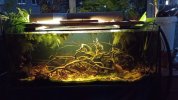martink
Member
- Messages
- 72
my substrate was 30%peat 60% sand. i just left the tank for three months with no fish in it. unfortunately a week before I got my fish one of the tubing for the filter folded over and i added seed pods which absolutely crashed the tank. I fixed it got the water tested and bought fish. there was some aggression so i bought a few pencil fish. i believe some died the first night and i didnt notice and their corpses basically poisoned the tank. ive been doing water changes at about 30% daily since but most of my adoketa died. The stronger pair of fish have survived but the female is not happy. the male is completley fine actually having the time of his life but i see that listless swimming in the female and gill scratching which tells me there is a water problem. I bought a second filter after the first crash so ive got 2x 1000l p/hr on a 165 litre tank. all that is in there is sand peat and wood with some waterlettuce and oak leaves. I have the tank well aerated because the fish were gasping at the surface first night but stopped completely when i let the outlets drop from height. i have to add, before i added the pencil fish all the fish were fine. since adding its been a complete disaster. im now trying to tackle the black sand problem as that might be whats causing issues over and above the aftermath of the dead pencil fish. how do i go about this black sand, do i move the sand around? - internet says yes and no. do i buy more substrate and just trap the black sand underneath more sand or steadily replace? any help will be good. one more thing is that even though my tank water is 80ppm tds, the tank is 200. only wood and leaves. i also add rainwater because of this high number but only getting 10litres a week. could the black sand be causing this spike? i feel like im in a husbandry nightmare and cant wake up. please help if you can. thanks



